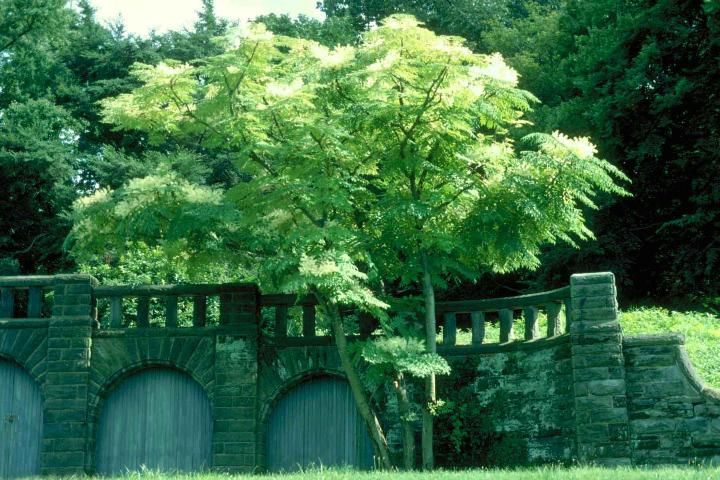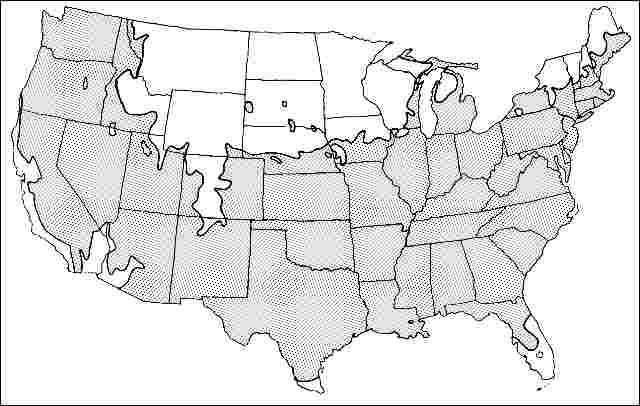Aralia spinosa: Devils-Walkingstick1
Introduction
Anyone who has accidentally brushed against a devil's-walkingstick does not soon forget the experience, for this tall, spindly native shrub or small tree is armed up and down its thin trunk with extremely sharp, treacherous spines. Even the huge, much-divided leaves, which can reach four feet long and three feet wide, are armed with pointed prickles, ready to scratch anyone who comes within range. But when placed in an area where they can do no harm, devil's-walkingsticks add a tropical effect to a mixed shrubbery border or other naturalized setting, where the large leaves can easily spread out to their full length atop the slender, 10- to 15-foot-tall trunks. Under ideal conditions, these small trees can even reach 25 to 30 feet tall.

Credit: Ed Gilman
General Information
Scientific name: Aralia spinosa
Pronunciation: uh-RAIL-ee-uh spy-NO-suh
Common name(s): Devil's-walkingstick, Hercules-club
Family: Araliaceae
USDA hardiness zones: 5A through 9A (Fig. 2)
Origin: native to North America
Invasive potential: weedy native
Uses: specimen; reclamation
Availability: not native to North America

Description
Height: 10 to 15 feet
Spread: 6 to 10 feet
Crown uniformity: irregular
Crown shape: upright/erect
Crown density: open
Growth rate: moderate
Texture: fine
Foliage
Leaf arrangement: alternate (Fig. 3)
Leaf type: bipinnately compound, odd-pinnately compound
Leaf margin: serrate
Leaf shape: ovate
Leaf venation: pinnate
Leaf type and persistence: deciduous
Leaf blade length: 2 to 4 inches
Leaf color: green
Fall color: copper, red
Fall characteristic: not showy

Flower
Flower color: white/cream/gray
Flower characteristics: showy
Fruit
Fruit shape: round
Fruit length: less than .5 inch
Fruit covering: fleshy
Fruit color: purple, black
Fruit characteristics: attracts birds; not showy; fruit/leaves not a litter problem
Trunk and Branches
Trunk/bark/branches: branches don't droop; not showy; typically multi-trunked; no thorns
Pruning requirement: needed for strong structure
Breakage: susceptible to breakage
Current year twig color: gray, brown
Current year twig thickness: very thick
Wood specific gravity: unknown
Culture
Light requirement: full sun, partial sun or partial shade
Soil tolerances: clay; sand; loam; alkaline; acidic; extended flooding; well-drained
Drought tolerance: moderate
Aerosol salt tolerance: unknown
Other
Roots: not a problem
Winter interest: no
Outstanding tree: no
Ozone sensitivity: unknown
Verticillium wilt susceptibility: unknown
Pest resistance: free of serious pests and diseases
Use and Management
The young leaves of devil's-walkingstick are bronze-colored, green in summer, but return to a bronze/red mottled with some yellow before dropping in fall. As striking as the thorns are the large, summertime panicles of bloom, 12 to 18 inches in diameter and up to three feet long, held above the crown of leaves for about 10 days and gently draping outward under the weight of the flower head. Following these blooms is the production of a great quantity of dark, purple-black, juicy berries that are exceptionally popular with birds.
Devil's-walkingstick is quite easy to grow and literally thrives on neglect. Plants should be grown in full sun or partial shade on any almost any kind of soil, acid or alkaline, moist or dry, as long as it is well drained, and it is frequently found along stream banks and road sides. Devil's-walkingstick grows rapidly and usually spreads by sprouts produced from its base, eventually creating an impenetrable thicket if left to its own devices. While the temptation would be to use this plant as a barrier planting, the effect of the thorned, naked trunks during wintertime is quite harsh and perhaps unattractive to some people. The plant can be trained into a small, single or multi-stemmed tree and used in a shrubbery border to add height and interest, or left to create a thicket. It is not normally available in nurseries. It can be transplanted during winter and used as a specimen in an out-of-the-way place where it is sure to capture the curiosity of many visitors, particularly when it is in flower.
Propagation is by seed, sucker-division, or root cuttings, and plants are easily transplanted. A smaller, non-thorny selection of this plant would make a nice, native alternative to the ever-popular nandina shrub.
Pests and Diseases
No pests or diseases are of major concern.


